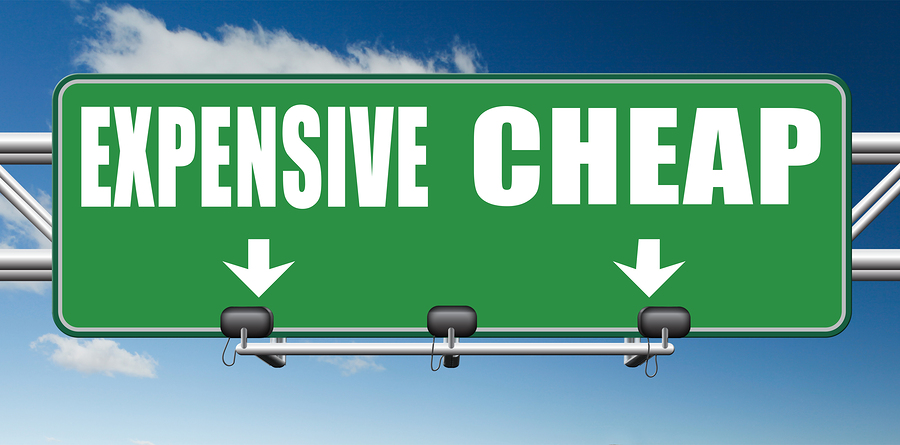 I occasionally enjoy a glass of wine after dinner, but I know virtually nothing about what makes one wine better than another. So when I’m at the grocery store and looking at the wines, all I really have to go on is price. Like most people, I assume that the more expensive bottle must be the better bottle.
I occasionally enjoy a glass of wine after dinner, but I know virtually nothing about what makes one wine better than another. So when I’m at the grocery store and looking at the wines, all I really have to go on is price. Like most people, I assume that the more expensive bottle must be the better bottle.
But is that true? Not necessarily. In fact, in one study a group of researchers swapped the labels of two bottles of wine, putting the expensive label on the cheap wine and the cheap label on the expensive wine. They then had two groups of people taste test the wine — one group saw the label and the price and the other group didn’t.
The group that thought the cheap wine was expensive consistently rated the “expensive” wine as being better than the “cheap” one. Not so with the group that didn’t get to see the labels or the prices.
Perception is Reality
The study makes clear what marketers have known for a very long time: perception is reality. If people think something is better they will often favor it even if the facts don’t backup the perception.
Especially when it comes to things they have little real knowledge about, people are inclined to assume that what costs more is probably better. Whether it’s a product like a bottle of wine or a professional service, the price often sets the expectation of value.
The funny thing about this is that if you asked people randomly whether or not more expensive products are always better, pretty much everybody is going to say “no”. But when it comes time to actually choose a product, people often buy the best they can afford (and sometimes more than they can afford).
Why?
The reason is simple: we know that higher price doesn’t always equate to better quality, but when shopping for products and services we have little knowledge about (like wine) we have no other way to judge quality! Especially when we’re buying products and services that are very personal and could affect our health, well-being or financial situation, people prefer not to go cheap if they don’t have to. It’s a way of limiting the risk that we’re getting an inferior product.
That’s why more people buy more expensive name brand medicine than generic, even though study after study shows that there’s no real difference between the two. Just in case the name brand is better, we tend to buy it if we can afford it because our health is at stake.
Underpricing Is Dangerous

These facts about human nature are why it can be dangerous to underprice yourself. If you’re out to sell a product or service, you want people to perceive it as being of high quality. Since people generally don’t have a lot of real world knowledge about the products and services they’re buying, price often greatly influences a person’s perception of quality.
This is especially so with professional services. People are looking to pay somebody else for the service because they don’t have the knowledge or skills to perform it themselves.
If you are selling a service and you underprice yourself, people will tend to think that the service you’re offering must not be as good as what your higher priced competition is offering. Some people are bargain shoppers and will buy from you just because you’re cheaper or because you’re all they can afford. If that’s your target market, fine, but if you don’t want to survive on thin margins you’ll have a real perception problem if you “race toward the bottom” just to be cheaper than the competition.
Crafting Perception
 Of course, just setting a high price tag isn’t going to result in people flocking to you because they assume you must be the best. You have to backup that perception.
Of course, just setting a high price tag isn’t going to result in people flocking to you because they assume you must be the best. You have to backup that perception.
For example, let’s say you’re in the market for an attorney for your business. You see a great-looking professional ad for a specific attorney with lots of convincing reasons to give them a try. The hourly rate is high, but your legal issue is an important one so you make an appointment for a consultation. At this point your perceived value of this attorney is very high.
Now let’s say you go to the attorney’s office and (1) the office is a run down building and (2) there’s no secretary or legal assistant, only the attorney and (3) (s)he is driving a beat up old car and wearing raggedy clothes.
Would you still trust that this attorney is great? Probably not.
Do those 3 factors necessarily mean (s)he’s not great? No. It’s possible that (s)he is a fantastic lawyer and just prefers not to spend all of the money on an expensive office, employees, car or clothes. Certainly possible, but you don’t know that. You base your perception on what you know, and what you know is that a great attorney should be able to afford all of those things and it appears that this one can’t.
So if you’re going to set your price high, you need to be sure that you’re backing up your high price with the perception of high quality as well. This should not be a game of smoke and mirrors. The actual service or product you provide should be high quality, resulting in a satisfied customer.
Real World Example: Apple Versus Android
 I am an Android person myself. I own a Samsung Galaxy phone. Although I think Apple makes great products (I’m typing this on my Macbook Pro), when it comes to phones I just prefer Android. Being a tech guy, I understand that the hardware and software in an Android phone is not inferior to that in an iPhone. In fact, in many cases there’s better hardware in higher end Android devices.
I am an Android person myself. I own a Samsung Galaxy phone. Although I think Apple makes great products (I’m typing this on my Macbook Pro), when it comes to phones I just prefer Android. Being a tech guy, I understand that the hardware and software in an Android phone is not inferior to that in an iPhone. In fact, in many cases there’s better hardware in higher end Android devices.
So why is the iPhone so much more expensive as a rule?
Because perception is reality. Apple has done a fantastic job of crafting the perception of their product as being better than the competition. Again, this is not smoke and mirrors. The iPhone is a great product, but is it better than a high end Android phone? From a technical standpoint at least, it’s not.
But if you asked the typical person on the street which they would prefer to own if they could afford either, what answer would you get? Aside from the occasional techy like me, I bet most people would prefer an iPhone if they could afford it. Perception is reality, and in the war of perception Apple is winning at this point. In fact, sales of Samsung devices is slumping this year while the iPhone is selling like hotcakes.
The Take Away
I hope I’ve made it clear that perception is everything when it comes to marketing your products or services, and why people tend to use price as a gauge of quality — at least initially. So set your price according to the market you’re targeting. If you’re trying to be the low cost leader of your market, fine. There’s money to be made there — just ask Wal-Mart!
But if you don’t want to survive on thin profit margins like Wal-Mart does, then you need to craft your market’s perception of you carefully. Price is one great way to do that, so don’t underprice yourself and by all means back up your higher price with higher value.
Oh, and in case you think this doesn’t apply to the “little guy”, my wife is an artist. For a long time she sold her artwork for what I told her was far too little money given her talent level. Recently I finally convinced her to raise her prices, and yesterday she sold a beautiful piece of her work for many times more than her norm to a local chiropractor. Perception is reality!
As always, I’d love to hear your thoughts and questions, so feel free to post them in a comment below.













